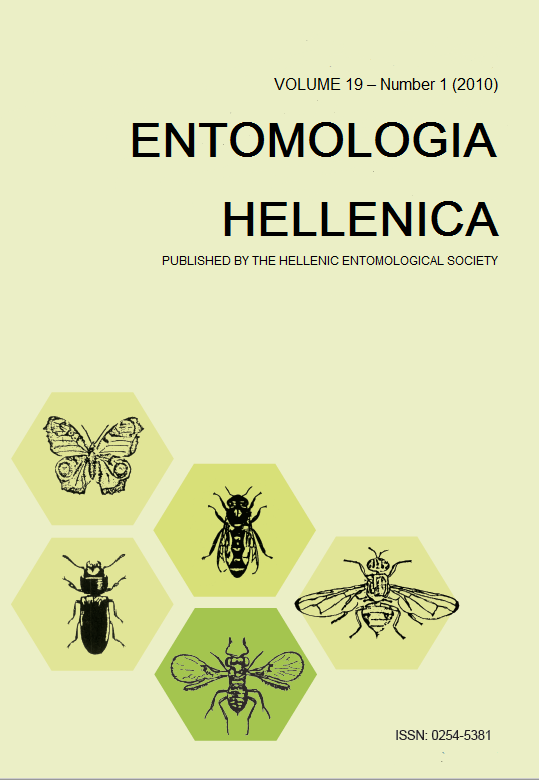Αξιολόγηση της αποτελεσματικότητας νέων εντομοκτόνων για την καταπολέμηση του ψευδόκοκκου της αμπέλου Planococcus ficus στην Τυνησία
Περίληψη
Οι ψευδόκοκκοι (Hemiptera: Pseudococcidae) προκαλούν σοβαρές οικονομικές απώλειες σε πολλές αμπελουργικές περιοχές στην Τυνησία. Σε μια προσπάθεια βελτίωσης των στρατη- γικών διαχείρισης του ψευδόκοκκου της αμπέλου Pseudococcus ficus (Signoret), αξιολο- γήθηκαν 3 εντομοκτόνα, imidacloprid, Prev-Am και spirotetramat, για την αποτε- λεσματικότητά τους στο είδος αυτό σε σχέση με το methidathion. Το διασυστηματικό εντο- μοκτόνο spirotetramat (Movento® 150 OD) έδωσε την μεγαλύτερη αποτελεσματικότητα σε σύγκριση με το εντομοκτόνο επαφής methidathion, το διασυστηματικό imidacloprid που εφαρ- μόστηκε στα αυλάκια ποτίσματος και με το νέο βιοεντομοκτόνο επαφής Prev-Am. Τρεις εβδομάδες μετά την εφαρμογή, δεν υπήρχαν αυγά του ψευδόκοκκου και ενήλικα θηλυκά στα κλήματα όπου είχε εφαρμοστεί το spirotetramat. Ακόμη, το spirotetramat, είχε μεγάλη υπο- λειμματική δράση για τους πληθυσμούς του ψευδόκοκκου και εμπόδισε την περαιτέρω εξά- πλωσή τους στα φύλλα της αμπέλου. Επομένως, το νέο αυτό διασυστηματικό εντομοκτόνο θα μπορούσε να συμπεριληφθεί σε ένα πρόγραμμα Ολοκληρωμένης Διαχείρισης για την καταπολέμηση του ψευδόκοκκου στους αμπελώνες της Τυνησίας. Παρά τη μικρή υπολειμ- ματικότητά του το Prev-Am® φάνηκε να είναι πιο αποτελεσματικό τόσο από το methidathion όσο και από το imidacloprid, κυρίως για τα αυγά του ψευδόκοκκου και τις νύμφες 3ης ηλικίας και είχε ως αποτέλεσμα τη μέγιστη μείωση του αριθμού νυμφών 1ης και 2ης ηλικίας στους βλαστούς της αμπέλου. Συνεπώς και το βιοεντομοκτόνο αυτό θα μπορούσε να αποδειχθεί χρήσιμο για την διαχείριση του ψευδόκοκκου σε αμπελώνες.
Λεπτομέρειες άρθρου
- Πώς να δημιουργήσετε Αναφορές
-
Mansour, R., Grissa Lebdi, K., & Rezgui, S. (2017). Αξιολόγηση της αποτελεσματικότητας νέων εντομοκτόνων για την καταπολέμηση του ψευδόκοκκου της αμπέλου Planococcus ficus στην Τυνησία. ENTOMOLOGIA HELLENICA, 19(1), 21–33. https://doi.org/10.12681/eh.11591
- Τεύχος
- Τόμ. 19 Αρ. 1 (2010)
- Ενότητα
- Articles

Αυτή η εργασία είναι αδειοδοτημένη υπό το CC Αναφορά Δημιουργού – Μη Εμπορική Χρήση – Παρόμοια Διανομή 4.0.
Authors who publish with this journal agree to the following terms:
Authors retain copyright and grant the journal right of first publication with the work simultaneously licensed under a Creative Commons 4.0 license.
Authors are able to enter into separate, additional contractual arrangements for the non-exclusive distribution of the journal's published version of the work (e.g. post it to an institutional repository or publish it in a book), with an acknowledgement of its initial publication in this journal. Authors are permitted and encouraged to post their work online (preferably in institutional repositories or on their website) prior to and during the submission process, as it can lead to productive exchanges, as well as earlier and greater citation of published work.



